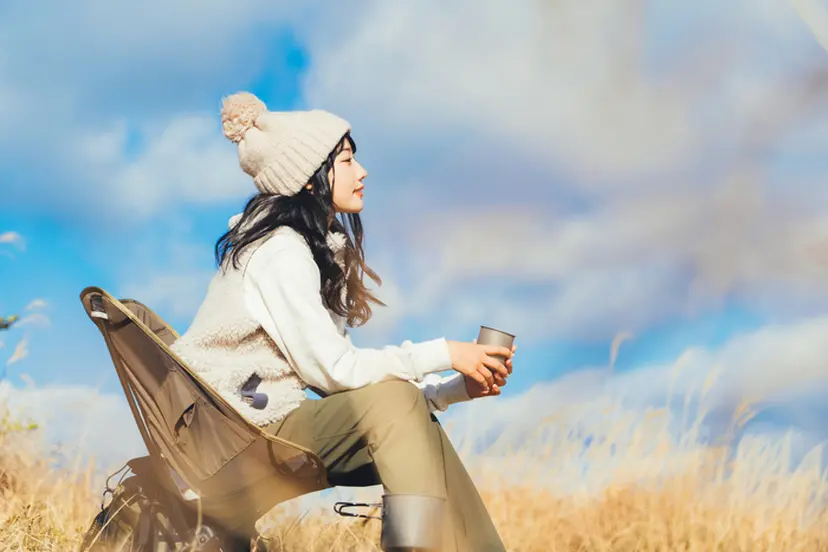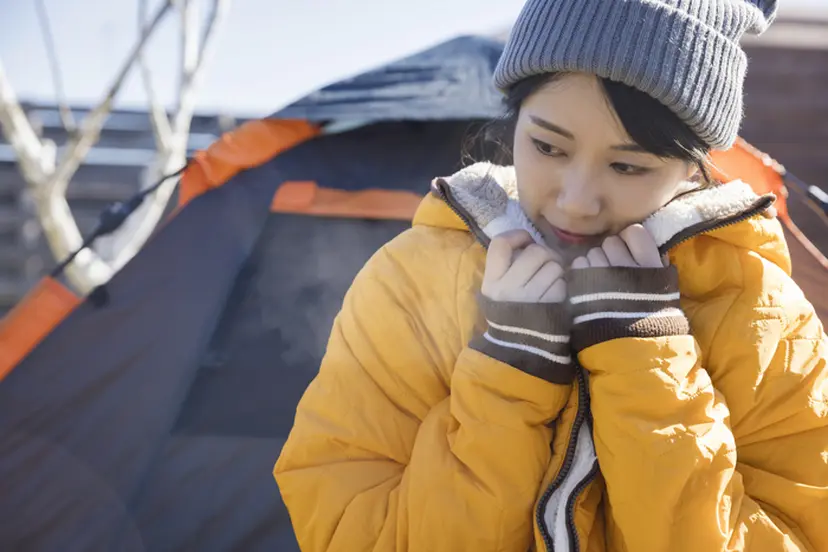Although camps are often associated with summer recreation, winter camping also offers many attractions not found in summer. If you are well aware of the precautions for winter camping, it can be as good an experience as summer camping. In this article, we will introduce the attractions and precautions of winter camping, as well as another option: winter camping with a camper.
 Five points to keep in mind for safe and enjoyable winter camping
Five points to keep in mind for safe and enjoyable winter camping
Provide adequate winter protection
Naturally, it is very cold outdoors in winter, so it is necessary to take measures against the cold, such as wearing heavy clothing and preparing heating equipment. In addition to waterproof and windproof outerwear, you should prepare warm inner wear, gloves, hats, and body warmers to prevent your body temperature from dropping due to perspiration. A mat to prevent the bottom from getting cold and a sleeping bag with good thermal protection are also important. Failure to take the necessary cold protection measures can be fatal in winter camping, so it is recommended that you bring more luggage and consult with the caretaker if you are not sure how to get the most out of your camping experience.
Bring more water
Many campgrounds allow you to take water, but in winter, it is important to bring more water than in summer, assuming that the water supply may not be available due to anti-freezing measures.
 Pay attention to tent safety
Pay attention to tent safety
Because of the possibility of more snow in winter camping, special attention should be paid to tent safety. For example, if the heat from people melts the snow under the tent, the pegs may come loose and the tent may collapse in the wind, so make sure to step firmly and pile the snow a little higher where you sleep. Waterproof spray is an effective way to protect your tent from freezing. Choosing a tent suitable for winter camping rather than year-round camping will also increase safety.
Take precautions against condensation
Condensation is inevitable when camping in winter, when the temperature outside the tent is cooler. To prevent condensation as much as possible, take measures such as opening the ventilation open a little to ventilate the tent even when sleeping, and using mats with heat-insulating effects to control condensation. It is also effective to keep the sleeping area away from the tent walls in case of condensation, and to prepare wipers or towels to wipe off condensation.
Take precautions against icy road surfaces
If you are driving to winter camp, you will need to take precautions against icy road surfaces along the way. The roads in winter are often in serious conditions, such as sherbet-like road surfaces caused by fresh snow and melting snow, and black ice, which appears to be free of snow but is frozen and slippery, so it is essential to change to studless tires. The need for studded tires and chains is especially important if you are going in a camper, as the vehicle is heavier and has a higher center of gravity, increasing the need for studded tires and chains.
 Winter Camping Tips About Clothing by Temperature
Winter Camping Tips About Clothing by Temperature
The basic winter camping attire is layering and keeping your feet and head warm. Here are some examples of recommended clothing by temperature, so you can use them as a guide to help you choose the right outfit for the time and place you want to go.
Temperatures below 10-15°C
Temperatures between 10 and 15 degrees Celsius are the same as those in late October and November in plain areas such as Tokyo. At this temperature, it is often comfortable during the daytime without getting that cold, but in the morning and at night, it suddenly gets cold, so it is important to be able to adjust your clothing easily.
 Prepare a moisture-absorbent, breathable inner layer that dries sweat during the day. For a middle layer, a slightly thicker sweatshirt is perfect. A lightweight long-sleeved T-shirt is recommended for high daytime temperatures. A windproof mountain parka as an out layer should also be prepared in case of cold nighttime temperatures and chilly winds.
Prepare a moisture-absorbent, breathable inner layer that dries sweat during the day. For a middle layer, a slightly thicker sweatshirt is perfect. A lightweight long-sleeved T-shirt is recommended for high daytime temperatures. A windproof mountain parka as an out layer should also be prepared in case of cold nighttime temperatures and chilly winds.
Recommended clothing for temperatures below 10-15°C:
- Sweat-absorbent, quick-drying inner wear
- Long-sleeved T-shirt or sweatshirt
- Mountain parka
- Outdoor pants
Temperature 5°C to less than 10°C
Temperatures between 5°C and 10°C require full-fledged winter camping equipment. In the plains, this is the temperature in December or January. The base layer should be a warm, water-absorbing, breathable inner layer.
For the middle layer, a fleece or sweater with good insulation and a light inner down layer as a spare are recommended. For an out layer, bring a windproof and water-repellent mountain parka. In addition, when the temperatures reach this level, it is recommended that you prepare a must-have accessory item. It is important to be prepared to keep body heat from escaping, especially from your feet and head.
Recommended clothing for temperatures between 5°C and 10°C:
- Sweat-absorbent and quick-drying inner wear
- Sweater or fleece
- Mountain parka
- Outdoor pants
- Neck/leg warmers, gloves, knit hat
Temperatures below 5°C
 When the temperature is below 5°C, the campsite is less crowded, and it is the kind of temperature that attracts true winter campers. The mornings and evenings are so cold that you may not be able to sleep at all unless you are well-prepared. Wear an inner layer, both top and bottom. I recommend merino wool material for its high heat retention properties.
When the temperature is below 5°C, the campsite is less crowded, and it is the kind of temperature that attracts true winter campers. The mornings and evenings are so cold that you may not be able to sleep at all unless you are well-prepared. Wear an inner layer, both top and bottom. I recommend merino wool material for its high heat retention properties.
For a base layer, we recommend layering a fleece and a down layer. Make sure the body heat does not escape. Pants should be made of down, which has high heat retention properties.
Furthermore, when the temperature is below 5 degrees Celsius, clothing alone is not enough. It is important to be well-prepared, for example, by applying a warmer to places with large blood vessels (such as the back of the neck) and preparing a hot-water bottle.
Recommended clothing for temperatures below 5°C:
- Thick sweat-absorbent, quick-drying inner wear (top and bottom)
- Sweater or fleece
- Down jacket and pants
- Mountain parka
- Neck/leg warmers, gloves, knit hat

Whether you sleep in a tent or go out in a camper, the charm of winter camping is that you can enjoy the extraordinary experience that only winter can offer. If you go to a campground after taking sufficient precautions against the cold, you will be able to enjoy a valuable experience that is second to none in summer camping.